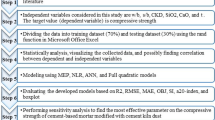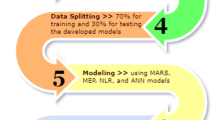Abstract
In the current study, the effect of cement kiln dust on the fresh and hardened cement mortar was investigated; chemical analysis of the binder was also included. Cement kiln dust (CKD) content (% by dry weight of cement) was from 0 to 100%. The fresh property of the cement was evaluated by flow table test, and the evaluation of hardened properties was based on the compressive strength, flexural strength, and stress–strain behavior of the mortar. Standard sand was used in the current study with a ratio of sand-to-binder (s/b) 3 and a water-to-binder ratio of 0.5. Also, cement and CKD were characterized based on microstructure tests, X-ray diffraction (XRD) and scanning electron microscopy, and thermogravimetric analysis to determine the weight loss of CKD and cement under high temperature. Three distinct models (linear regression model (LR), adaptive regression spline (MARS), and artificial neural network (ANN)) were utilized to generate predictive models to estimate the compressive strength of CKD-modified cement mortar, the current study data and 162 collected data from different research studies were used in the model development. The collected data were a combination of datasets with different w/b, s/b, CKD, silicon dioxide content in the binder (SiO2), calcium oxide content in the binder (CaO, %), maximum size of fine aggregate (MSA, mm), and curing times of the samples (t, days). Additionally, the coefficient of determination (R2), scatter index, mean absolute error, and mean absolute percentage error were used to evaluate the effectiveness of the generated models. According to the results of experimental work, increasing CKD content decreased the compressive strength and flexural strength of cement mortar. Furthermore, the modeling analysis showed that the ANN model was better than the LR and MARS model for predicting the compressive strength of CKD-modified cement mortar.

























Similar content being viewed by others
Data availability
The data supporting the conclusions of this article are included in the article.
References
Najim KB, Mahmod ZS, Atea A-KM (2014) Experimental investigation on using Cement Kiln Dust (CKD) as a cement replacement material in producing modified cement mortar. Constr Build Mater 55:5–12
Seo M, Lee S-Y, Lee C, Cho S-S (2019) Recycling of cement kiln dust as a raw material for cement. Environments 6(10):113
Alnahhal W, Taha R, Al-Nasseri H, Nishad S (2018) Effect of using Cement Kiln Dust as a nano-material on the strength of cement mortars. KSCE J Civ Eng 22(4):1361–1368
Apostolopoulou M, Asteris PG, Armaghani DJ, Douvika MG, Lourenço PB, Cavaleri L, Moropoulou A (2020) Mapping and holistic design of natural hydraulic lime mortars. Cem Concr Res 136:106167
Asteris PG, Koopialipoor M, Armaghani DJ, Kotsonis EA, Lourenço PB (2021) Prediction of cement-based mortars compressive strength using machine learning techniques. Neural Comput Appl 33(19):13089–13121
Asteris PG, Skentou AD, Bardhan A, Samui P, Pilakoutas K (2021) Predicting concrete compressive strength using hybrid ensembling of surrogate machine learning models. Cem Concr Res 145:10644
Asteris PG, Apostolopoulou M, Armaghani DJ, Cavaleri L, Chountalas AT, Guney D et al (2020) On the metaheuristic models for the prediction of cement-metakaolin mortars compressive strength. Metaheuristic Comput Appl 1(1):63–99
Apostolopoulou M, Aggelakopoulou E, Siouta L, Bakolas A, Douvika M, Asteris PG, Moropoulou A (2017) A methodological approach for the selection of compatible and performable restoration mortars in seismic hazard areas. Constr Build Mater 155:1–14
Rahimzadeh CY, Mohammed AS, Barzinjy AA (2022) Microstructure characterizations, thermal analysis, and compression stress–strain behavior of lime-based plaster. Constr Build Mater 350:128921
Jiang C, Fan K, Wu F, Chen D (2014) Experimental study on the mechanical properties and microstructure of chopped basalt fibre reinforced concrete. Mater Des 58:187–193
Golinejad S, Mirjalili MH (2020) Fast and cost-effective preparation of plant cells for scanning electron microscopy (SEM) analysis. Anal Biochem 609:113920
Mohammed A, Abdullah A (2018) Scanning electron microscopy (SEM): a review. In: Proceedings of the 2018 international conference on hydraulics and pneumatics—HERVEX, Băile Govora, Romania, vol 2018, pp 7–9
Mohammed A, Mahmood W, Ghafor K (2020) TGA, rheological properties with maximum shear stress and compressive strength of cement-based grout modified with polycarboxylate polymers. Constr Build Mater 235:117534
Escalante J, Chen W-H, Tabatabaei M, Hoang AT, Kwon EE, Lin K-YA, Saravanakumar A (2022) Pyrolysis of lignocellulosic, algal, plastic, and other biomass wastes for biofuel production and circular bioeconomy: A review of thermogravimetric analysis (TGA) approach. Renew Sustain Energy Rev 169:112914
Rahimzadeh CY, Barzinjy AA, Mohammed AS, Hamad SM (2022) Green synthesis of SiO2 nanoparticles from Rhus coriaria L. extract: comparison with chemically synthesized SiO2 nanoparticles. PLoS ONE 17(8):0268184
Piro NS, Hamad SM, Mohammed AS, Barzinjy AA (2022) Green Synthesis Magnetite (Fe3O4) Nanoparticles from Rhus Coriaria extract: a characteristic comparison with a conventional chemical method. IEEE Trans NanoBiosci 22(2):308–317
British Standards Institution (2016) Methods of testing cement: determination of setting times and soundness. BSI
BS En (2010) Methods of Testing Cement. Determination of fineness. British Standards Institute, London, pp 196–206
En ASRO (2016) Methods of testing cement. Determination of strength, Romanian Standard Association, Bucharest
Friedman JH (1991) Multivariate adaptive regression splines. Ann Stat 19(1):1–67
Safari MJS (2019) Decision tree (DT), generalized regression neural network (GR) and multivariate adaptive regression splines (MARS) models for sediment transport in sewer pipes. Water Sci Technol 79(6):1113–1122
Sihag P, Jain P, Kumar M (2018) Modelling of impact of water quality on recharging rate of storm water filter system using various kernel function based regression. Model Earth Syst Environ 4(1):61–68. https://doi.org/10.1007/s40808-017-0410-0
Marangu JM (2020) Prediction of compressive strength of calcined clay based cement mortars using support vector machine and artificial neural network techniques. J Sustain Constr Mater Technol 5(1):392–398. https://doi.org/10.29187/jscmt.2020.43
Thongsanitgarn P, Wongkeo W, Sinthupinyo S, Chaipanich A (2012) Effect of limestone powders on compressive strength and setting time of Portland-limestone cement pastes. Adv Mater Res 343:322–326
Mohammed AS (2018) Vipulanandan models to predict the electrical resistivity, rheological properties and compressive stress-strain behavior of oil well cement modified with silica nanoparticles. Egypt J Pet 27(4):1265–1273
Mohammed A, Salih A, Raof H (2020) Vipulanandan constitutive models to predict the rheological properties and stress–strain behavior of cement grouts modified with metakaolin. ASTM International, West Conshohocken
Despotovic M, Nedic V, Despotovic D, Cvetanovic S (2016) Evaluation of empirical models for predicting monthly mean horizontal diffuse solar radiation. Renew Sustain Energy Rev 56:246–260. https://doi.org/10.1016/j.rser.2015.11.058
Meng Q-B, Wang C-K, Liu J-F, Zhang M-W, Lu M-M, Wu Y (2020) Physical and micro-structural characteristics of limestone after high temperature exposure. Bull Eng Geol Env 79(3):1259–1274
Öner M, Erdoğdu K, Günlü A (2003) Effect of components fineness on strength of blast furnace slag cement. Cem Concr Res 33(4):463–469
Al-Jabri K, Shoukry H (2014) Use of nano-structured waste materials for improving mechanical, physical and structural properties of cement mortar. Constr Build Mater 73:636–644. https://doi.org/10.1016/j.conbuildmat.2014.10.004
ASTM C1437 (2013) Test method for flow of hydraulic cement mortar. American Society for Testing and Materials, West Conshohocken
Al-Faluji D, Al-Rubaye MM, Nasr MS, Shubbar AA, Al-Khafaji ZS, Alkhayyat A, Abdulraheem MS (2021) Impact of substitute portland cement with CKD on the mechanical and durability characteristics of cement mortar. IOP Publ. https://doi.org/10.1088/1757-899X/1090/1/012035
Marku J, Dumi I, Lico E, Dilo T, Cakaj O (2012) The characterization and the utilization of cement kiln dust (CKD) as partial replacement of Portland cement in mortar and concrete production. Zaštita materijala 53(4):334–344
Abd El-Aleem S, Abd-El-Aziz MA, Heikal M, El Didamony H (2005) Effect of cement kiln dust substitution on chemical and physical properties and compressive strength of Portland and slag cements. Arab J Sci Eng 30(2B):264
Bardhan A, Gokceoglu C, Burman A, Samui P, Asteris PG (2021) Efficient computational techniques for predicting the California bearing ratio of soil in soaked conditions. Eng Geol 291:106239
Bardhan A, Alzo’ubi AK, Palanivelu S, Hamidian P, GuhaRay A, Kumar G, Asteris PG (2023) A hybrid approach of ANN and improved PSO for estimating soaked CBR of subgrade soils of heavy-haul railway corridor. Int J Pavement Eng 24(1):2176494
Bardhan A, Asteris PG (2023) Application of hybrid ANN paradigms built with nature inspired meta-heuristics for modelling soil compaction parameters. Transp Geotech 41:100995
Hakkomaz H, Yorulmaz H, Durak U, İlkentapar S, Karahan O, Atiş CD (2022) The influence of cement kiln dust on strength and durability properties of cement-based systems. Environ Sci Pollut Res 29(50):76166–76175
Acknowledgements
The Civil Engineering Department, University of Sulaimani, Gasin Cement Co., supported this study.
Funding
This work had no funding.
Author information
Authors and Affiliations
Corresponding authors
Ethics declarations
Conflict of interest
The authors declare that they have no conflict of interest.
Ethical approval
This article does not contain any studies with human participants or animals. performed by any author.
Rights and permissions
Springer Nature or its licensor (e.g. a society or other partner) holds exclusive rights to this article under a publishing agreement with the author(s) or other rightsholder(s); author self-archiving of the accepted manuscript version of this article is solely governed by the terms of such publishing agreement and applicable law.
About this article
Cite this article
Mohammed, A.S., Abdalla, A.A., Kurda, R. et al. Soft computing techniques to estimate the uniaxial compressive strength of mortar incorporated with cement kiln dust. Innov. Infrastruct. Solut. 8, 300 (2023). https://doi.org/10.1007/s41062-023-01273-9
Received:
Accepted:
Published:
DOI: https://doi.org/10.1007/s41062-023-01273-9




